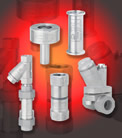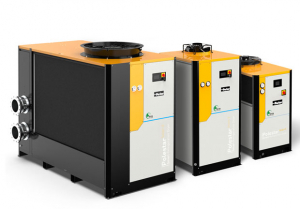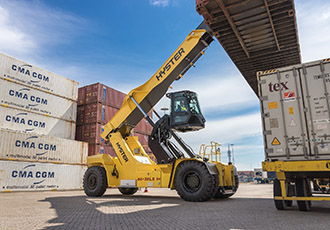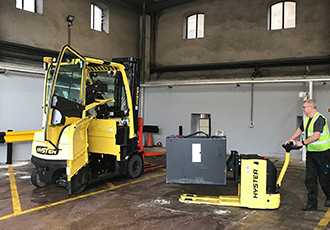Efficient steam production in paper mills
4th November 2008
Source:
Thermal Energy International

The paper and pulp industry is an energy and emission intensive industry. Steam is an essential part of the paper making process with steam boilers, steam distribution systems and other processes accounting for a large percentage of a paper mill’s energy costs. Useful energy is often lost from boilers and process equipment such as heat exchangers, dryers, evaporators etc, as well as from transporting steam from boilers to different areas of the plant. Although a mill may well have a cascade steam system on the paper machine(s), mechanical trap failure can needlessly elevate fuel bills and emission costs by over 20%.
Steam traps have the function of removing condensed steam and non-condensable gases without losing any live steam. It is anticipated that up to 20% of mechanical steam traps could be malfunctioning in a paper plant at any one time accounting for massive increases in energy costs.
Where condensate is not returned, the water is lost as well excessive amounts of energy. The result is a significant economic loss, directly via increased boiler running costs, and potentially indirectly onto production via decreased steam heat capacity. Steam leakage through traps can account for an astonishing 55% in some high usage processing industries, such as paper.
Steam traps need to be working at optimum efficiency with a minimum impact on the environment. For example, a stand steam system could be losing 22% of energy from the boiler, 25% from distribution and a further 5% from other processes resulting in only 48% useful energy. If a steam system were working at maximum optimisation, useful energy would be increased to 75%.
Steam traps can have different sized orifices to suit different conditions. If a trap leaks steam, the amount wasted will depend on the size of the trap and the steam pressure. The cost of waste will also depend on the number of traps and the operating time. For example a paper mill with 200 traps based on an average trap size of DN20 and a stream pressure of 14-bar g with 10% failing annually will have steam wastage of 8,900 tonnes. If the overall cost of steam for this plant were £20 per tonne, the direct cost of ignoring these leaking steam traps would be £356,000 each year, which is equivalent to well over a million litres of fuel oil. The cost to the environment would be 3,000 tonnes of CO2 dumped into the atmosphere each year.
Paper mills are looking for ways of reducing overheads and many are cutting maintenance budgets and staff. The consequence is a spiral of ever-increasing steam loss and escalating fuel bills as maintenance is cut and failed mechanical steam traps remain open blowing live steam. This has left management with two options; either minimal maintenance or watch the steam plumes rise along with the fuel, water and chemical treatment costs or regularly test, repair and replace faulty mechanical traps at considerable ongoing cost.
There are numerous steam traps available and selecting the correct type of steam trap is an important element of any steam system. Whilst Thermostatic, Thermodynamic and Mechanical are extensively used, the Fixed Orifice Condense Discharge Trap is now becoming the steam trap of choice. Instead of utilising a valve mechanism to close off steam for maximum energy and water conservation, the venturi orifice design effectively drains condensate from the steam system. As these steam traps have no moving parts to wedge open or fail, they provide the ultimate in reliability necessitating only minimal maintenance and requiring no spares, testing or monitoring equipment. They are available in a range of options for specific applications, manufactured from corrosion resistant stainless steel and are performance guaranteed for 10 years, obviating the need for repair or replacement.
A performance analysis carried out by Queen’s University, Belfast into efficiency of steam traps has shown that, over varying condensate loads and steam pressures, the venturi trap is the most efficient steam trap available. In the research a variety of steam traps were utilised including buckets, floats, thermostatic and thermodynamic valve arrangements. Tests were performed on each trap at a constant pressure of 54 psig (3.7bar) and varying flows from ‘no flow’ to 20 kg/hr. The results proved that venturi steam traps are significantly more efficient over varying loads than all other types of traps with the free floating float trap and the more conventional float trap the least efficient with losses averaging over 1.5 kg/hr.
For example a major paper company in Kent installed 25 venturi orifice steam traps on a series of coater batteries that resulted in £125,000 saving on an investment of just £25,000 in just over 2 months. Other customers in the paper industry have seen an increase in condensate return from just 28% to a staggering 70%.
Replacing preheater and end corrugator rolls with twelve venturi orifice designed steam traps resulted in drop of 11% in fuel usage. Similarly replacing mechanical traps with the venturi orifice design resulted in steam savings of 30%. Overall a paper mill can achieve savings of 1.1tonnes/hour by converting to venturi orifice steam traps, which equates to an increase in sales of £1 million.
In many paper mills many of the steam traps are actually steam wasters. The complacency of ignoring steam traps is costing steam users much more than they realise. The hard reality of a plant maintaining its boiler and forgetting about the rest of the steam system can be a horribly wasteful proposition. Losses can include not only wasted energy but also replacement of damaged equipment and misuse of man-hours. Fortunately, installing low maintenance orifice venturi steam traps can avert much of these potential losses
Where condensate is not returned, the water is lost as well excessive amounts of energy. The result is a significant economic loss, directly via increased boiler running costs, and potentially indirectly onto production via decreased steam heat capacity. Steam leakage through traps can account for an astonishing 55% in some high usage processing industries, such as paper.
Steam traps need to be working at optimum efficiency with a minimum impact on the environment. For example, a stand steam system could be losing 22% of energy from the boiler, 25% from distribution and a further 5% from other processes resulting in only 48% useful energy. If a steam system were working at maximum optimisation, useful energy would be increased to 75%.
Steam traps can have different sized orifices to suit different conditions. If a trap leaks steam, the amount wasted will depend on the size of the trap and the steam pressure. The cost of waste will also depend on the number of traps and the operating time. For example a paper mill with 200 traps based on an average trap size of DN20 and a stream pressure of 14-bar g with 10% failing annually will have steam wastage of 8,900 tonnes. If the overall cost of steam for this plant were £20 per tonne, the direct cost of ignoring these leaking steam traps would be £356,000 each year, which is equivalent to well over a million litres of fuel oil. The cost to the environment would be 3,000 tonnes of CO2 dumped into the atmosphere each year.
Paper mills are looking for ways of reducing overheads and many are cutting maintenance budgets and staff. The consequence is a spiral of ever-increasing steam loss and escalating fuel bills as maintenance is cut and failed mechanical steam traps remain open blowing live steam. This has left management with two options; either minimal maintenance or watch the steam plumes rise along with the fuel, water and chemical treatment costs or regularly test, repair and replace faulty mechanical traps at considerable ongoing cost.
There are numerous steam traps available and selecting the correct type of steam trap is an important element of any steam system. Whilst Thermostatic, Thermodynamic and Mechanical are extensively used, the Fixed Orifice Condense Discharge Trap is now becoming the steam trap of choice. Instead of utilising a valve mechanism to close off steam for maximum energy and water conservation, the venturi orifice design effectively drains condensate from the steam system. As these steam traps have no moving parts to wedge open or fail, they provide the ultimate in reliability necessitating only minimal maintenance and requiring no spares, testing or monitoring equipment. They are available in a range of options for specific applications, manufactured from corrosion resistant stainless steel and are performance guaranteed for 10 years, obviating the need for repair or replacement.
A performance analysis carried out by Queen’s University, Belfast into efficiency of steam traps has shown that, over varying condensate loads and steam pressures, the venturi trap is the most efficient steam trap available. In the research a variety of steam traps were utilised including buckets, floats, thermostatic and thermodynamic valve arrangements. Tests were performed on each trap at a constant pressure of 54 psig (3.7bar) and varying flows from ‘no flow’ to 20 kg/hr. The results proved that venturi steam traps are significantly more efficient over varying loads than all other types of traps with the free floating float trap and the more conventional float trap the least efficient with losses averaging over 1.5 kg/hr.
For example a major paper company in Kent installed 25 venturi orifice steam traps on a series of coater batteries that resulted in £125,000 saving on an investment of just £25,000 in just over 2 months. Other customers in the paper industry have seen an increase in condensate return from just 28% to a staggering 70%.
Replacing preheater and end corrugator rolls with twelve venturi orifice designed steam traps resulted in drop of 11% in fuel usage. Similarly replacing mechanical traps with the venturi orifice design resulted in steam savings of 30%. Overall a paper mill can achieve savings of 1.1tonnes/hour by converting to venturi orifice steam traps, which equates to an increase in sales of £1 million.
In many paper mills many of the steam traps are actually steam wasters. The complacency of ignoring steam traps is costing steam users much more than they realise. The hard reality of a plant maintaining its boiler and forgetting about the rest of the steam system can be a horribly wasteful proposition. Losses can include not only wasted energy but also replacement of damaged equipment and misuse of man-hours. Fortunately, installing low maintenance orifice venturi steam traps can avert much of these potential losses
Similar articles
More from Thermal Energy International
- Italian Pharmaceutical Company Enjoys Fast Payback On GEM Steam Traps 11th May 2012
- HOSPITAL LAUNDRY’S ENERGY AND WATER COSTS TUMBLE AND CO2 EMISSIONS FALL AFTER FITTING GEM STEAM TRAPS 31st January 2012
- Thermal Energy International Raises The Bar On Thermal Efficiency On Stand C8 At Maintec 2012 29th November 2011
- Thermal Energy International’S Gem Traps Provide 9.4% Energy Savings At Servizi Ospedalieri, Italy 14th November 2011
Product Centre Updates
2024 World Battery & Energy Storage Industry Expo (WBE)
8th August 2024
China 1st and 2nd Floor, Area A, China Import and Export Fair Complex




.jpg)







Write a comment
No comments